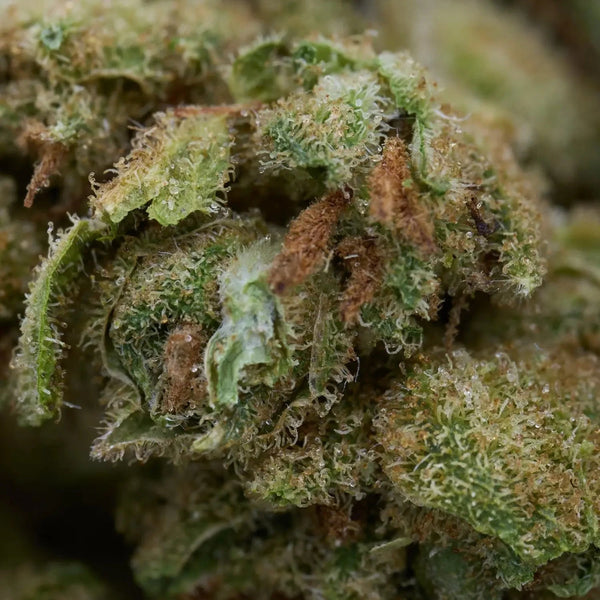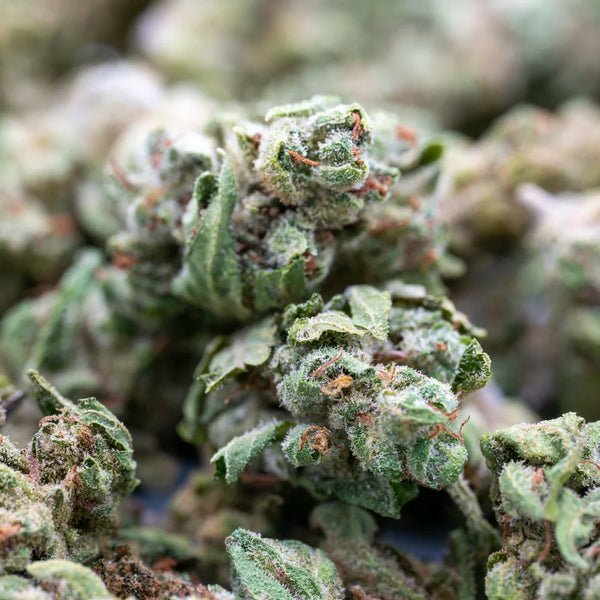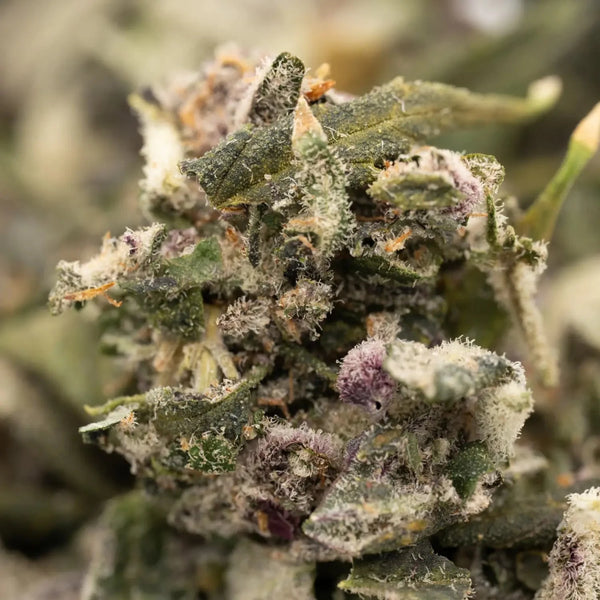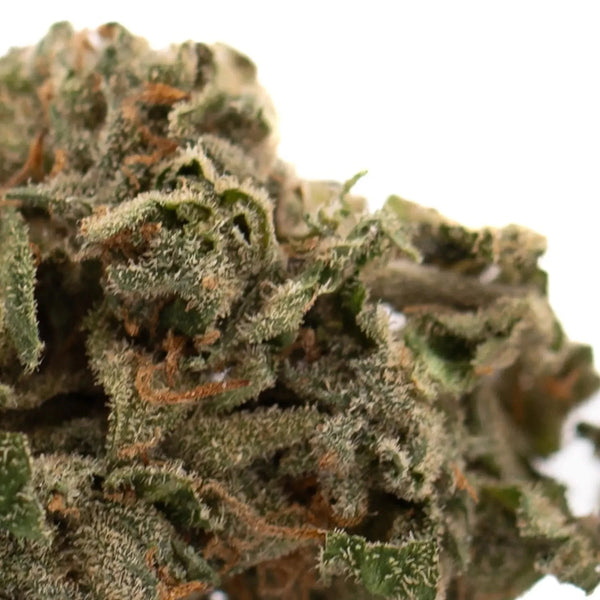No Products in the Cart
Free 2-3 day USPS Priority Shipping With Orders Over $85

If you've ever wondered why raw cannabis doesn't produce the same effects as smoked or vaporized flower, the answer lies in a crucial chemical process called decarboxylation. This transformation is the key to understanding how THCA converts to THC, and it's essential knowledge for anyone working with cannabis concentrates, edibles, or flower.
Whether you're an experienced dabber or new to concentrates, understanding THCA decarboxylation fundamentally changes how you approach consumption. It's not just academic chemistry—it's practical knowledge that directly impacts the potency, flavor, and overall experience of your cannabis products.
Many consumers mistakenly believe that THCA and THC are interchangeable terms for the same compound. This common misconception can lead to confusion when reading product labels, unexpected experiences with edibles, or ineffective consumption methods. The reality is that THCA (tetrahydrocannabinolic acid) is the non-intoxicating precursor to THC (tetrahydrocannabinol), and understanding the decarboxylation process is crucial for anyone seeking the full therapeutic or recreational effects of cannabis.
When you purchase THCA products, you're essentially buying raw, inactive cannabinoids that require activation through heat. This is why you can't simply eat raw flower and expect to feel effects—the THCA hasn't been converted to THC yet. The decarboxylation process is what bridges the gap between potential and actual psychoactive effects.
For concentrate enthusiasts, understanding THCA to THC conversion is particularly important. When you're dabbing at high temperatures or using a vaporizer, you're performing instantaneous decarboxylation. The temperature you choose, the duration of heat application, and the method you use all dramatically affect the conversion rate, potency, and even the flavor profile of your concentrate.
This knowledge empowers you to make informed decisions about consumption methods, optimize your experience, and avoid wasting valuable concentrates through improper technique. Whether you're making edibles from concentrates or simply want to perfect your dabbing temperature, understanding the science behind THCA heat activation gives you complete control over your cannabis experience.
At its core, decarboxylation is a chemical reaction that removes a carboxyl group (COOH) from a molecule. In the context of cannabis, it specifically refers to the process of converting THCA to THC through the application of heat or, over extended periods, through natural aging.
Think of decarboxylation as "activating" your cannabis. In fresh, raw cannabis plants, cannabinoids exist primarily in their acidic forms—THCA, CBDA, CBGA, and others. These acid forms have a molecular structure that includes an extra THCA carboxyl group (a carbon atom double-bonded to an oxygen atom and single-bonded to a hydroxyl group). This additional molecular component is what makes THCA non-intoxicating.
When heat is applied to THCA, this carboxyl group breaks away from the molecule in the form of carbon dioxide (CO₂) and water vapor (H₂O). What remains is THC—the compound responsible for the psychoactive effects cannabis is known for. This transformation is irreversible; once THCA becomes THC, it cannot revert to its acidic form.
The process isn't unique to cannabis. Decarboxylation occurs in many organic compounds and is a fundamental concept in organic chemistry. However, in the cannabis world, it's particularly significant because it's the difference between inactive plant matter and activated, effects-producing medicine or recreation.
The THCA carboxyl group is attached at a specific position on the molecule's ring structure. When sufficient energy (in the form of heat) is introduced, the bond holding this carboxyl group weakens and eventually breaks. This release of CO₂ is what creates the characteristic smell when cannabis is heated—part of that aroma is literally the decarboxylation happening in real-time.
The molecular weight difference between THCA and THC is approximately 12.3%. This means that 100mg of pure THCA will yield approximately 87.7mg of THC after complete decarboxylation. This conversion ratio is important for anyone making edibles or trying to calculate precise dosing from THCA concentrates.
The chemical reaction can be expressed simply as:
THCA → THC + CO₂
In more detail:
This equation shows that one molecule of THCA becomes one molecule of THC, releasing one molecule of carbon dioxide in the process. The reaction requires activation energy, which is provided by heat. The temperature and duration of heat application determine how efficiently this conversion occurs.
The term "decarb" is simply shorthand for decarboxylation, and you'll hear it frequently in cannabis communities. When someone says they need to "decarb" their concentrate or flower, they're referring to the process of heating it to convert THCA to THC before using it in edibles or tinctures. The "carb" portion of the word comes from "carboxyl"—the molecular group being removed during the process.

Heat is the catalyst that drives the decarboxylation process, but not all heat is created equal. The temperature, duration, and method of heat application all significantly impact the efficiency and completeness of THCA to THC conversion.
The optimal decarb temperature for converting THCA to THC falls within a specific range: 220-250°F (104-121°C). This temperature range represents the sweet spot where decarboxylation occurs efficiently without degrading the THC into less desirable cannabinoids or destroying valuable terpenes.
At temperatures below 200°F (93°C), decarboxylation still occurs, but the process is extremely slow and may take hours to achieve complete conversion. This is why cannabis that sits in hot cars or storage areas may gradually decarboxylate over time, though not completely.
The THCA activation temperature begins around 200°F (93°C), but the reaction rate increases significantly as temperatures rise. At 220°F, decarboxylation proceeds at a moderate pace, typically requiring 30-45 minutes for near-complete conversion when using oven methods. At 250°F, the same conversion might occur in 20-30 minutes.
However, there's a critical upper limit. When temperatures exceed 300°F (149°C), THC begins to degrade into CBN (cannabinol), a cannabinoid with different, generally less desirable effects. CBN is more sedative and less psychoactive than THC. This degradation accelerates rapidly above 350°F, which is why precise temperature control is crucial for maintaining potency.
The THCA THC conversion rate is not instantaneous at lower temperatures—it follows a time-temperature relationship. Lower temperatures require longer exposure times, while higher temperatures achieve conversion more quickly. This relationship is logarithmic rather than linear, meaning that small temperature increases can significantly reduce the time needed for complete decarboxylation.
For oven decarboxylation of concentrates or flower:
These timeframes assume even heat distribution and proper material preparation. Concentrates typically decarb faster than flower due to their concentrated nature and lack of plant material that can insulate THCA molecules from heat.
When you take a dab, you're applying your THCA concentrate to a surface heated to 400-600°F or even higher. At these temperatures, THCA heat activation occurs almost instantaneously—within milliseconds to seconds.
The dabbing temperature THCA conversion is so rapid because the extreme heat provides more than enough activation energy for the reaction. The THCA molecules essentially flash-decarboxylate the moment they contact the heated surface. This is why you can feel effects almost immediately when dabbing—there's no waiting for gradual conversion as there would be with lower-temperature methods.
However, the high temperatures used in dabbing come with a tradeoff. While you achieve instant, complete conversion, you also risk degrading THC into CBN and destroying heat-sensitive terpenes. This is why many experienced users prefer lower-temperature dabs in the 450-550°F range—hot enough for complete decarboxylation but cool enough to preserve more of the flavor compounds and prevent excessive THC degradation.
Vaporizers offer more precise control over the decarboxylation temperature for THCA. Most quality vaporizers allow you to set exact temperatures, giving you control over both the conversion efficiency and the compounds released.
For THCA products, vaporizer settings between 350-400°F (177-204°C) provide excellent decarboxylation while preserving terpenes and minimizing THC degradation. At 350°F, you get a more flavorful experience with slightly slower conversion, while 400°F provides faster, more complete decarboxylation with slightly diminished flavor.
Many users employ a technique called "temperature stepping," starting at lower temperatures (320-350°F) to release terpenes and partially decarboxylate THCA, then gradually increasing to 380-400°F for complete conversion. This method maximizes both flavor and effect while minimizing waste.
Understanding the various methods for decarbing THCA concentrates allows you to choose the best approach for your specific application and desired outcome.
Dabbing represents the fastest method for how THCA converts to THC. When you apply concentrate to a heated nail, banger, or e-nail set to 400-600°F, decarboxylation occurs in under a second. The extreme heat provides instant activation, which is why effects are felt so rapidly compared to other consumption methods.
The ideal dabbing temperature for THCA conversion while preserving flavor and minimizing degradation is:
Low-temperature dabbing has become increasingly popular among connoisseurs because it provides complete THCA conversion while maintaining the full terpene profile. The trade-off is that you may need to re-heat and take multiple draws to fully vaporize all the concentrate.
Vaporizers designed for concentrates offer the most precise control over the decarboxylation science involved in activation. Unlike dabbing, which uses extreme, rapidly fluctuating temperatures, concentrate vaporizers maintain steady temperatures that you can adjust for optimal results.
This controlled environment allows for more efficient conversion with less waste. You can start at lower temperatures to release the most volatile terpenes, then gradually increase heat to ensure complete decarboxylation without overshooting into the degradation range. Many electronic vaporizers feature preset temperature curves specifically designed for concentrate consumption, automating the temperature-stepping process.
When making edibles from THCA concentrates, oven decarboxylation is the preferred method. This process allows you to activate large quantities of concentrate before infusing it into butter, oils, or other edible preparations.
The standard oven decarb method:
To decarb THCA concentrate effectively in an oven, monitor the material closely. When active decarboxylation is occurring, you'll see small bubbles forming and rising through the concentrate. When these bubbles slow to a near stop, decarboxylation is essentially complete. Continuing to heat beyond this point only risks THC degradation.
Some experienced users prefer slightly lower temperatures (220°F) for longer periods (45-60 minutes) to minimize any THC loss to degradation. The trade-off is longer processing time, but the results can be marginally higher in retained potency.
THCA can also convert to THC naturally over time through exposure to light, air, and ambient heat—though this process is extremely slow and inconsistent. Cannabis stored in hot, bright conditions will gradually decarboxylate over months or years, but you cannot rely on this method for controlled, predictable conversion.
Natural decarboxylation is generally considered undesirable because it's uncontrolled and often accompanied by degradation of both THCA and THC into CBN. However, understanding this process is important for storage—if you want to preserve THCA in its acid form (for its unique potential benefits), store your concentrates in cool, dark, airtight containers.
UV light particularly accelerates both decarboxylation and degradation, which is why quality THCA products are typically stored in opaque, UV-resistant containers.

Achieving optimal THCA to THC conversion requires balancing several factors that affect both the efficiency of decarboxylation and the preservation of potency.
When heat is insufficient, you won't achieve complete THCA decarboxylation, leaving you with a mixture of THCA and THC. While THCA does have its own potential therapeutic benefits, if you're seeking the psychoactive effects of THC, incomplete conversion means reduced potency and unpredictable effects.
At temperatures below 200°F, decarboxylation occurs so slowly that you'd need hours or even days of continuous heat exposure for complete conversion. Between 200-220°F, conversion proceeds but may take 60-90 minutes to reach completion. If you remove your material from heat before the reaction finishes, you're left with partially converted product.
Signs of incomplete decarboxylation in concentrates:
The opposite problem—excessive heat—is equally problematic. Above 300°F, THC begins converting to CBN, a process that accelerates dramatically above 350°F. CBN produces primarily sedative effects and is significantly less psychoactive than THC.
This is particularly relevant for dabbing. Taking dabs at extremely high temperatures (700°F+) might feel more powerful due to faster, larger vapor production, but you're actually degrading a portion of your THC before you can inhale it. The harsh, cough-inducing nature of high-temperature dabs is partly due to this degradation creating irritating byproducts.
Optimal temperature control means finding the range where how heat activates THCA efficiently without pushing into the degradation zone. For most applications, this sweet spot is 220-250°F for slow decarb or 450-550°F for rapid consumption methods like dabbing.
The ideal dabbing temperature for THCA balances several competing factors:
Low-temp (450-550°F):
Medium-temp (550-650°F):
High-temp (650°F+):
For most users seeking the best balance of effect and experience, the 500-600°F range represents the optimal dabbing temperature. This ensures complete, instant THCA heat activation while preserving most terpenes and minimizing waste through degradation.
Terpenes—the aromatic compounds that give cannabis its distinctive flavors and aromas—are highly volatile and sensitive to heat. Many terpenes begin to evaporate at temperatures as low as 310°F, with most fully volatilizing by 400°F.
When decarbing THCA concentrates, the goal is to activate the THCA without unnecessarily destroying terpenes. This is why covered containers are recommended for oven decarboxylation—they trap terpene vapors, allowing them to recondense back into the concentrate as it cools.
For dabbing, this is why low-temperature dabs have become the gold standard among flavor enthusiasts. At 500-550°F, you achieve complete decarboxylation while preserving more of the delicate monoterpenes like myrcene, limonene, and pinene. These compounds contribute not only to flavor but also to the entourage effect—the synergistic interaction between cannabinoids and terpenes that enhances overall effects.
Being able to interpret lab testing results is essential for understanding exactly what you're getting when you purchase THCA products and predicting the effects after decarboxylation.
Professional cannabis testing laboratories can measure cannabinoid profiles with high precision using techniques like High-Performance Liquid Chromatography (HPLC) or Gas Chromatography (GC). However, there's an important distinction between these methods when it comes to measuring THCA.
HPLC testing measures cannabinoids in their actual form without applying heat, giving you separate values for THCA and THC. This is the preferred method for determining the true cannabinoid profile of unheated products.
GC testing, conversely, heats the sample during analysis, which causes decarboxylation. This method automatically converts THCA to THC during testing, so results show only THC even if the original sample contained primarily THCA. This is why it's important to understand which testing method was used when reading certificates of analysis.
When you see a concentrate labeled as "85% THCA," this number represents the concentration of THCA in its acid form. However, this isn't the amount of THC you'll get after converting THCA to THC.
Due to the molecular weight difference (THCA is approximately 12.3% heavier than THC because of the carboxyl group), you need to multiply the THCA percentage by 0.877 to calculate the potential THC content after complete decarboxylation.
Example calculation:
This conversion factor is crucial for accurate dosing, especially when making edibles from concentrates.
Many modern labels include both "THCA" and "Total THC" values. The Total THC calculation accounts for the potential THC you'd get from complete decarboxylation and is calculated as:
Total THC = THC + (THCA × 0.877)
This Total THC value gives you a more accurate picture of the product's potential potency after THCA decarboxylation. It's the number you should reference when calculating edible dosages or comparing product potencies.
Some states require this Total THC calculation on labels, while others only report THCA and THC separately. Always check which values your label displays to avoid under- or overestimating potency.
A Certificate of Analysis (COA) is a comprehensive lab report that details the cannabinoid profile, terpene content, and safety testing results for a cannabis product. When examining a COA for THCA concentrates, look for:
Cannabinoid Profile:
Terpene Profile:
Safety Testing:
A quality COA provides transparency and allows you to make informed decisions about products. When purchasing THCA products, always verify that current COAs are available and that the batch number on your product matches the tested batch.

Understanding decarboxylation science transforms from academic knowledge to practical skill when you apply it to real-world consumption scenarios.
Creating edibles from concentrates requires complete, controlled decarboxylation before infusion. Unlike flower, which can be decarbed and used directly in some recipes, concentrates must be fully activated and then properly emulsified into fats or oils.
Step-by-step concentrate edible process:
The advantage of starting with concentrates is precision. Flower can vary in potency and contains plant material that affects flavor, while concentrates provide consistent, predictable dosing and a clean taste profile in finished edibles.
One of the most powerful applications of understanding THCA activation temperature is the ability to precisely control effects through temperature manipulation.
For vaporizing or dabbing:
This isn't just about heat—it's about controlling which compounds are released and in what ratios. Lower temperatures preferentially release lighter terpenes and create a THC-dominant vapor with minimal CBN. Higher temperatures release everything, including creating CBN through degradation, shifting the effect profile toward sedation.
The growing preference for low-temperature dabbing among experienced users isn't just about flavor—it's about optimizing the THCA THC conversion rate while minimizing degradation.
At 500-550°F, you achieve:
The technique requires patience—you must wait longer for your nail or banger to cool to the target temperature after heating. Some users employ temperature-reading devices or timed cooling periods to ensure consistency. E-nails eliminate the guesswork by maintaining precise, stable temperatures.
While low-temp dabs might not produce the massive vapor clouds of high-temperature dabs, they deliver a superior experience in terms of flavor, effect quality, and efficiency. You're consuming more of what you paid for and less of what results from heat degradation.
The science of how THCA converts to THC through decarboxylation is more than chemistry—it's the foundation of effective, enjoyable cannabis consumption. Understanding this process empowers you to make informed decisions about consumption methods, optimize your technique, and maximize the value of your THCA products.
Without proper decarboxylation, THCA remains in its acid form, providing none of the psychoactive effects that most users seek. Whether you're dabbing, vaporizing, or creating edibles, the decarboxylation process is the critical step that transforms potential into reality.
Every consumption method you choose is essentially a different decarboxylation technique, each with its own temperature profile, time requirements, and efficiency characteristics. Dabbing provides instant conversion through extreme heat. Vaporizing offers controlled, sustained conversion at moderate temperatures. Oven decarboxylation allows you to activate large quantities precisely for edible preparation.
The optimal decarb temperature isn't just about achieving conversion—it's about achieving conversion while preserving the compounds that make each strain unique. The difference between a harsh, degraded dab and a flavorful, effective one often comes down to 50-100°F.
Temperature control allows you to:
Whether you invest in an e-nail for perfect dabbing temperatures or simply learn to time your heat-and-cool cycles, this level of control transforms your consumption from guesswork to precision.
Understanding decarboxylation science means you're no longer at the mercy of trial and error. You know why certain temperatures work better, what's happening at a molecular level, and how to achieve your desired results consistently.
This knowledge helps you:
The difference between THCA and THC might be a single carboxyl group at a molecular level, but in practical terms, it's the difference between inactive plant material and activated medicine or recreation. Mastering the art and science of THCA heat activation puts you in complete control of your cannabis experience.
Master your dabbing technique and explore premium THCA concentrates that respond beautifully to proper temperature control. Every product comes with detailed COAs so you know exactly what you're activating.
Q: What temperature do I need to convert THCA to THC?
A: The optimal decarb temperature for converting THCA to THC is 220-250°F (104-121°C) for oven decarboxylation methods. For dabbing, temperatures between 450-600°F provide instant conversion while preserving quality. Anything below 200°F converts too slowly, while temperatures above 300°F risk degrading THC into CBN.
Q: How long does it take to decarb THCA concentrate?
A: Using the oven method at 240°F, complete THCA decarboxylation typically takes 30-40 minutes. You'll know it's complete when bubbling (CO₂ release) slows to a near stop. When dabbing or vaporizing, conversion happens almost instantly due to the higher temperatures involved—within seconds or less.
Q: Can I eat THCA concentrate without decarbing it?
A: You can, but you won't experience psychoactive effects. Raw THCA is not intoxicating because it hasn't been converted to THC. To make effective edibles, you must first decarb THCA concentrate in an oven at 220-250°F for 30-45 minutes before infusing it into fats or oils. THCA may have its own potential benefits, but it won't produce the typical THC experience.
Q: Does THCA convert to THC naturally over time?
A: Yes, but extremely slowly and unpredictably. Exposure to light, heat, and air will gradually cause THCA to THC conversion over months or years, but this natural process is inconsistent and often accompanied by degradation into CBN. For controlled, reliable conversion, intentional heat application is necessary. Store concentrates in cool, dark, airtight containers to minimize unwanted natural decarboxylation.
Q: What's the difference between THCA percentage and Total THC?
A: THCA percentage tells you how much THCA is in the product before decarboxylation. Total THC is a calculated value showing potential THC after complete conversion: Total THC = THC + (THCA × 0.877). The 0.877 multiplier accounts for the 12.3% molecular weight loss when the carboxyl group is removed. Always reference Total THC when calculating THCA concentrates for edible dosing.
Q: Why do my dabs taste harsh?
A: Harsh-tasting dabs usually indicate excessive temperature that's degrading THC and destroying terpenes. The ideal dabbing temperature for THCA is 500-600°F for most concentrates. Try waiting 10-15 seconds longer after heating your nail or banger, or invest in an e-nail or temperature gun to ensure you're in the optimal range. Lower temperatures produce smoother, more flavorful vapor.
Q: How do I know when my concentrate is fully decarbed?
A: During oven decarboxylation, active THCA decarboxylation produces visible bubbles as CO₂ is released. When these bubbles slow to nearly stopping, conversion is essentially complete. If you reheat the material and it still bubbles significantly, it needs more time. Most concentrates are fully decarbed at 240°F after 30-40 minutes.
Q: Will decarbing destroy terpenes?
A: Some terpene loss is inevitable during decarboxylation, but it can be minimized. Covering your material during oven decarb allows terpene vapors to recondense as it cools. Using lower temperatures (220°F) for slightly longer times also preserves more terpenes. For dabbing, staying in the 500-600°F range rather than going higher retains 60-80% of terpenes versus only 20-30% at extreme temperatures. The decarboxylation process always involves some terpene trade-off, but proper technique minimizes losses.
Q: Can I decarb in a microwave or slow cooker?
A: While possible, these methods aren't recommended for converting THCA to THC. Microwaves create uneven hot spots that can degrade some areas while leaving others unconverted. Slow cookers can work but are difficult to control precisely—most don't maintain the ideal 220-250°F range consistently. An oven with an accurate thermometer remains the best option for controlled, even decarboxylation of concentrates for edibles.